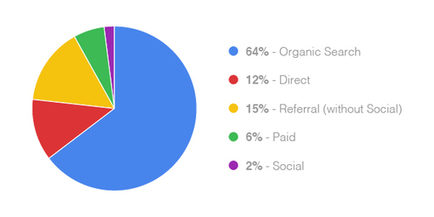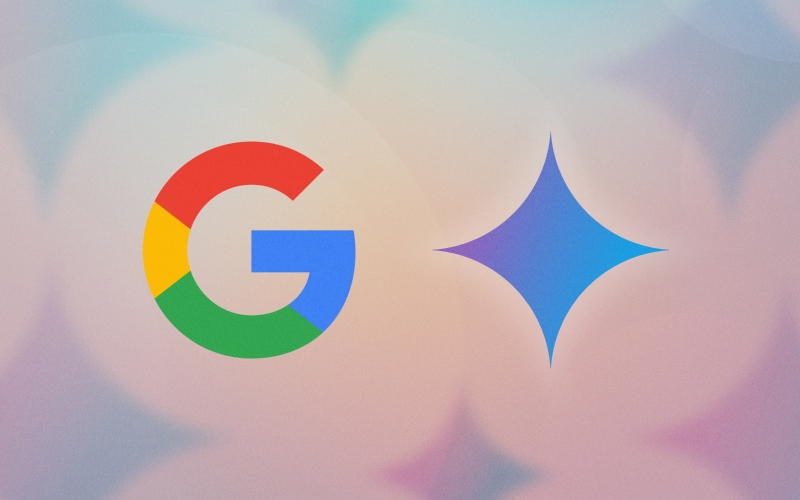Search
TL;DR instructions: read the last paragraph.
A brand is greater than the summation of its parts. It’s not just an experience, a feeling, a logo, a slogan, a product or any other combination of attributes that describe a business. A brand is all of the tangible and intangible things that provide unique benefits to your customer.
At its core, a brand is a promise.
A website is a primary customer touch point for a brand, and it, too, needs to fulfill that brand’s promise. Unfortunately, your website isn’t a magical baseball diamond in Iowa, and visitors won’t come just because you built it.
Enter SEO, which for the bold and uninitiated (Hey, grandma! Thanks for the brownie care package!) stands for search engine optimization. As consumers spend more time connected to their devices, search engines increasingly act as the conduit between their brains and your brand.
Just how important are search engines?
In August 2013, Google suffered an outage that rendered all of Google’s services unavailable for five minutes. According to multiple web analytics firms, during that short window of time, 40 percent of global internet traffic disappeared.
In a widely sourced 2014 internet traffic study, Conductor analyzed 310 million website visits and concluded that organic search is responsible for 64 percent of total website visits. When you consider that other studies have shown 6 percent of total website visits come from paid search, that adds up to an impressive 70 percent of website visitors from search engines.

Close your eyes for a second. Imagine how your brand would be impacted if 70 percent of your customers disappeared. If that sounds too Chicken Little for you, log into your Google Analytics account and navigate to the Source/Medium section. From there, you’ll be able to assess the impact of search engine traffic on your website, sales and brand.
The digital gatekeepers of your brand
Seth Godin, American entrepreneur, marketer and bestselling author of Tribes: We Need You to Lead Us, said, “A tribe is a group of people connected to one another, connected to a leader, and connected to an idea. For millions of years, human beings have been part of one tribe or another. A group needs only two things to be a tribe: a shared interest and a way to communicate.”
Think about that in relation to what it means for a brand. People need a shared interest and a way to communicate to be a part of a brand’s tribe.
If Facebook, Twitter, Whatsapp, Pinterest and other communication methods form the way people communicate today, how are shared interests formed?
Shared interests are cultivated from information and, sometimes, misinformation.
Don’t forget, search engines are now one of the primary sources for information gathering. That means the way search engines gather, organize and display information is vital to a brand’s success. Imagine a local coffee shop in Charlotte, NC, that doesn’t appear in Google’s search results for “coffee shops near me.” What does that say about this coffee shop? In a best case-scenario, it’s a missed opportunity to make a new brand advocate. In a worst-case scenario, it’s an opportunity for the coffee shop across the street to steal a current brand advocate. Either way, by not being there, it’s a missed opportunity for the invisible coffee shop to make a positive impression.
To understand search is to understand behavior
Who would dare try to make tiramisu without Googling it first? How would you make political decisions without searching for Saturday Night Live’s most recent debate video?
Search engines are the go-to resource for everything from dessert recipes and political news to bathroom ceramic tile ideas, maps and directions, restaurant reviews and baby-safe products.
But, let’s be honest. We don’t just search unfamiliar concepts and ideas anymore. We search everything.
As embarrassing as it is to admit, here’s an actual screenshot of what I’ve searched recently:

Many of those searches – from restaurant directions to estimating whether or not my propane tank had enough juice left in it for a Friday night barbeque – happened while on the go.
Pro tip: If you’re curious to find out just how much Google knows about you, log into your Google account and take a peek at the “My Activity” dashboard inside your “My Account” settings.
Brands are constantly evaluating their positioning, value propositions, target personas, customer behavior, shopping patterns and more. So is Google! By gaining an understanding of your customers’ search patterns and behaviors, you’ll discover the core principles that drive your brand.
Branding and micro-moments
Google refers to the rapid growth of on-the-go searches as micro-moments. It’s remarkable how much mobile has changed our expectations of brands. What was once a primarily linear consumer journey is now fractured into hundreds and even thousands of intent-driven micro-moments that happen in our cars, in our backyards, while we’re watching TV, after we propose to the person of our dreams, and every second in-between.
Thanks to mobile devices, there are 2.3 million Google searches per minute. That means brands now have an opportunity to be present in these micro-moments, anytime and anywhere. And in many ways, it’s more than an opportunity – it’s an expectation.
But, being there in those moments doesn’t happen naturally or easily for brands.
Lowe’s doesn’t expect Google to make sure its local store pops up when someone who recently moved to Charlotte searches, “home improvement store near me.” Instead, Lowe’s has entire search marketing teams, both internal teams and agency partners, working together to make sure the website can be easily indexed by Google and is search-friendly.

It’s no accident that Home Depot is missing from the results for this search query. If you’re curious why, email me, and I’d be glad to explain!
Just for a second, forget about keyword optimization and the thousands of technical factors that go into SEO, and think about it at its core. Beyond anything else, SEO is about providing the best user experience possible. Why? Because providing users the ultimate experience is also Google’s goal, and Google will accordingly serve the sites providing the best experiences higher on their search engine results pages.
SEO is not an ice cream topping
I wish SEO happened organically (pun intended). But the fact of the matter is, proper, brand-oriented search marketing is purposeful, strategic and mind-bendingly complex. Google’s algorithm is machine learning and takes hundreds of variables into consideration; to boot, its index automatically re-ranks websites every single time a query is submitted.
That’s why representing your brand across search engines – be it Google, Bing or Yahoo and paid, organic or local results – takes a considerable amount of time, research, strategy and ongoing optimization.
It’s all too common for brands to slap SEO and paid search into the overall marketing budget as an afterthought. Because, what’s more fun: planning a Super Bowl commercial or making sure your robots.txt file is clean? If you don’t know what a robots.txt file is, don’t worry. All you need to know is that if it’s improperly configured, that $1.5 million Super Bowl commercial just became useless.
And that’s the fantastic part about it. Brands have an incredible opportunity to fulfill their promises by dedicating more resources, time and thought to their search presence.
SEO sounds complex. Where does a brand even start?
What are the most commonly searched terms that lead people to your brand’s website? What number of variations do customers use to search for your brand’s products and services? What is the ratio of branded searches to non-branded searches?
These are just a small sample of questions that we ask when we begin a customer search discovery journey for our Wray Ward clients.
Numbers, charts and technical mumbo-jumbo can dilute the core purpose of a brand’s SEO efforts, so don’t let that hinder you. After you peel back the layers upon layers of data, you can paint a disturbingly clear picture of how your brand appears in your customers’ eyes (and Google’s).
Take the fictional law firm, Ziller Zwoble and Zuckerlittle. The partners Ziller and Zwoble are considering a rebranding project after Zuckerlittle’s retirement. They’d like to know how much brand equity is built into Zuckerlittle’s name.
The firm had 1,546 average monthly website visits from 19 completely different brand search terms. Much to Zwoble’s chagrin, 92 percent of total Google visits came from 17 search terms that did not include Zwoble in the search. The remaining partners weren’t expecting this at all, but they’re glad they know now.
Does this mean Zwoble is getting a boot from the firm’s name? What about Zuckerlittle?
That is a decision that Ziller and Zwoble will need to make. They could keep Zwoble in the name and re-think their logo and creative execution to put more emphasis on what is currently falling through the cracks. Or, perhaps despite Zuckerlittle’s recent retirement, they could also rebrand the firm Ziller and Zuckerlittle Law, since that’s where the overwhelming brand recall and search volume lie.
Either way, this type of information is invaluable, because it helps businesses improve their position by better understanding the characteristics customers and clients attribute to their brands. This tiny example of search behavior only cracks the surface of the importance of search to delivering a brand’s promise.
How does your brand appear?
Take a second and Google your brand’s name. What do you see? What does it mean? Can it be improved?
Below is a screenshot of Google’s organic brand result for Nike. It’s likely that you’ve stared at thousands of these types of organic search results without giving much thought about what shows up, how it shows up and why it shows up.

We could pick every line on this page apart for days, but instead I’ll tackle a couple of critical points:
- The first line of text, also known as a title tag, is displayed, “NIKE, Inc. – Inspiration and Innovation for Every Athlete in the World.”
- There are four secondary links directly below the headline that include options to go directly to the website’s Men and Women’s footwear sections.
- Nike’s own news content is displayed in the “In the News” section, which appears second and features an article about a new product called “Nike Mag.”
- The multifaceted section on the right, also known as the Google Knowledge Graph, displays critical brand information and links to the brand’s social profiles.
- Nike’s most popular recent Tweet is displayed third and includes the hashtag #NikeMag.
Everything from the words and punctuation to content type and order of that content has been fine-tuned and tested, and it will continue to adapt as both Nike and Google find ways to deliver the best results to their audiences.
Without diving into the technical details, even at a 50,000-foot perspective, the organic brand result shows us a couple of ways Nike is using SEO as a branding strategy.
- Promote new product offerings
- Promote Nike-owned and created content
- Offer customers a seamless way to get directly to the category of shoes the user would be interested in (Men vs. Women)
On average, there are 4,090,000 searches a month for “nike.” I won’t go full Bill Nye on you, but imagine how many more shoes Nike could sell by increasing the rate at which searchers click on a Nike link by just 3 percent. Assuming that the Nike website has an online sales conversion rate of 1 percent on brand searches, below is an example of how much more revenue Nike could make by improving its brand name CTR.
Example:
- “Nike” monthly searches: 4,090,000
- Current click-through rate on “nike”: 45%
- Average monthly clicks from “nike”= 1,840,500
- Average online sale conversion rate (1%): 18,405
- Average shoe sale price: $95
- Average monthly revenue from the term “nike”: $1,748,475
After improving the CTR by just 3% for the search “nike:”
- Nike’s optimized click-through rate: 46.35%
- Average monthly clicks: 1,895,715
- Average monthly online sales: 18,957
- Average shoe sale price: $95
- Average monthly revenue from the term “nike”: $1,800,915
Improving a CTR by 3 percent on a single search term is not an impossible task, and in this hypothetical situation, it would help Nike sell 6,624 more pairs of shoes a year, which means it would increase annual revenue by $629,280 per year.
Remember, we’re talking about a single search term. But that single search term could impact annual revenue by hundreds of thousands of dollars annually, and there are hundreds of thousands of different terms that drive traffic to Nike’s website and online store. Now, imagine if you could increase the CTR by 3 percent across all of those terms.
Search is branding
In a search specialist’s mind, there’s no discernable difference between search marketing and branding. Search engines are where future brand advocates go to dream. It’s where they go to plan. It’s where they go to learn. It’s where they go to be inspired. It’s where they go to learn how to make tiramisu.
So you don’t have to Google it, tiramisu is a layered dessert, often considered a cake, that is primarily flavored with coffee. It is thought that tiramisu originated in Italy’s Veneto in Europe in the 1960s, although other places and dates as late as the early 80s have been suggested.
Are there ways to improve the way your company delivers on its brand promise? Google it and find out ;). Then, contact me to find out if we can help you sell 6,624 more (insert your product here) per year.


